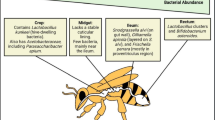Abstract
The influence of geographic location, season, age, and part of the digestive tract on bacterial diversity was evaluated on intestinal microflora of honeybees, wasps, and cockroaches using DGGE analysis. PCR-DGGE analyses with universal bacterial primers targeting 200-bp region of the 16S rDNA gene afforded the profile of complex bacterial DNA; specific primers were used to determine the profile of bifidobacteria whose concentration in digestive tract was determined by real-time PCR. Selected PCR products were identified by sequencing. The microflora of the bees exhibited little variations among the hives from distant locations. Their bifidobacterial population formed 2.8–8.4 % of total bacteria and was very homogeneous. The total gut microflora of wasps was also homogeneous, only two samples being affected by the season or the location; on the other hand, wasp bifidobacterial population was very heterogeneous. Cockroaches showed the highest variations in microflora composition, the age and diet being the ultimate factors; bifidobacteria counts also varied among tested individuals (0.1–34.1 % of total bacteria). Our results suggest that nutrition habits are the strongest factor affecting the insect microflora, giving higher variations to omnivorous species.
Similar content being viewed by others
Abbreviations
- DGGE:
-
denaturing gradient gel electrophoresis
- SSCP:
-
single-strand conformation polymorphism
- T-RFLP:
-
terminal restriction fragment length polymorphisms
References
Babndreier D., Joller D., Romeis J., Bigler F., Widmer F.: Bacterial community structures in honeybee intestines and their response to two insecticidal proteins. FEMS Microbiol.Lett. 59, 600–610 (2007).
Dasch G.A., Weiss E., Chang K.P.: Endosymbionts of insects, pp. 811–833 in N.R. Krieg, J.G. Holt (Eds): Bergey’s Manual of Systematic Bacteriology, Vol. 1. Williams and Wilkins, Baltimore (USA) 1984.
Dugas J.E., Zurek L., Paster B.J., Keddie B.A., Leadbetter E.R.: Isolation and characterization of a Chryseobacterium strain from the American cockroach, Periplaneta americana. Arch.Microbiol. 175, 259–262 (2001).
Elgderi R.M., Ghenghesh K.S., Berbash N.: Carriage by the German cockroach (Blattella germanica) of multiple-antibiotic-resistant bacteria that are potentially pathogenic to humans, in hospitals and households in Tripoli, Libya. Ann.Trop.Med.Parasitol. 100, 55–62 (2006).
Fischer S.G., Lerman L.S.: DNA fragments differing by single base-pair substitutions are separated in denaturing gradient gels: correspondence with melting theory. Proc.Nat.Acad.Sci.USA 80, 1579–1583 (1983).
Gilliam M.: Identification and roles of non-pathogenic microflora associated with honey bees. FEMS Microbiol.Lett. 155, 1–10 (1997).
Jeyaprakash A., Hoy M.A., Allsopp M.H.: Bacterial diversity in worker adults of Apis mellifera capensis and Apis mellifera scutellata (Insecta: Hymenoptera) assessed using 16S rRNA sequences. J.Invertebr.Pathol. 84, 96–103 (2003).
Kaufmann P., Pfefferkorn A., Teuber M., Meile L.: Identification and quantification of Bifidobacterium species isolated from food with genus-specific 16S rRNA-targeted probes by colony hybridization and PCR. Appl.Environ.Microbiol. 62, 3668–3672 (1997).
Kobayashi Y., Forster R.J., Teather R.M.: Development of a competitive polymerase chain reaction assay for the ruminal bacterium Butyrivibrio fibrisolvens OB156 and its use for tracking an OB156-derived recombinant. FEMS Microbiol.Lett. 188, 185–190 (2000).
Lo N., Beninati T., Stone F., Walker J., Sacchi L.: Cockroaches that lack Blattabacterium endosymbionts: the phylogenetically divergent genus Noticola. Biol.Lett. 3, 327–330 (2007).
Maidak B.L., Larsen N., McCaughey M.J., Overbeek R., Olsen G.J., Foge K., Blandy J., Woese C.R.: The ribosomal database project. Nucl.Acids Res. 22, 2385–3487 (1994).
Muyzer G., De Waal E.C., Uitterlinden A.G.: Profiling of complex microbial populations by denaturing gradient gel electrophoresis analysis of polymerase chain reaction-amplified genes coding for 16S rRNA. Appl.Environ.Microbiol. 59, 695–700 (1993).
Nardi J.B., Mackie R.I., Dawson J.O.: Could microbial symbionts of arthropod guts contribute significantly to nitrogen fixation in terrestrial ecosystems? J.Ins.Physiol. 48, 751–763 (2002).
Otvos L.: The short proline-rich antibacterial peptide family. Cell.Mol.Life Sci. 59, 1138–1150 (2002).
Pai H.H., Chen W.C., Peng C.F.: Isolation of bacteria with antibiotic resistance from household cockroaches (Periplaneta americana and Blattella germanica). Acta Tropica 93, 259–265 (2005).
Reeson A.F., Jankovic T., Kasper M.L., Rogers S., Austin A.D.: Application of 16S rDNA-DGGE to examine the microbial ecology associated with a social wasp Vespula germanica. Insect Mol.Biol. 12, 85–91 (2003).
Sambrook J., Fritsch E.F., Maniatis T.: Molecular Cloning: a Laboratory Manual, 2nd ed. Cold Spring Harbor Laboratory Press, Cold Spring Harbor 1989.
Temmerman R., Masco L., Vanhoutte T., Huys G., Swings J.: Development and validation of a nested-PCR-denaturing gradient gel electrophoresis method for taxonomic characterization of bifidobacteria communities. Appl.Environ.Microbiol. 69, 6380–6385 (1993).
Author information
Authors and Affiliations
Corresponding author
Additional information
These authors contributed equally to this work.
Rights and permissions
About this article
Cite this article
Mrázek, J., Štrosová, L., Fliegerová, K. et al. Diversity of insect intestinal microflora. Folia Microbiol 53, 229–233 (2008). https://doi.org/10.1007/s12223-008-0032-z
Received:
Accepted:
Published:
Issue Date:
DOI: https://doi.org/10.1007/s12223-008-0032-z




